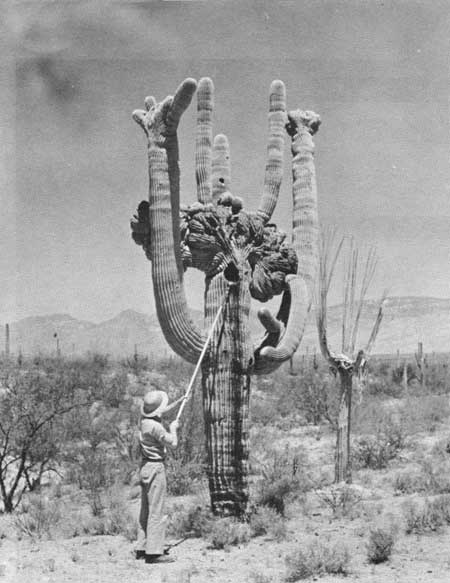|
SAGUARO National Park |
 |
The Monument Shares Southwest's Colorful History
That prehistoric man lived in the southwestern part of the monument is indicated by the crude petroglyphs (carved or stone-pecked pictures) found there. Centuries later, Papago and Opata Indians, from villages along the Santa Cruz River, once hunted and harvested saguaro fruits in this area.
Probably the first European to see the monument highlands was the Spaniard, Coronado, who with his exploring conquistadores from the south passed to the east of the Rincons in 1540. From then until it became a national monument in 1933, the history of the saguaro area is the history of the vicinity of Tucson, Ariz., established as a Spanish outpost in 1776. The Apaches of this area warred on the Spanish settlements, and later on the American settlers and the soldiers sent to protect them. This strife lasted for almost two centuries from the early 1700's until the capture of Geronimo in 1886.
 A rare cristate saguaro, a lesion, cleaned of the necrosis decay by a woodpecker, is indicated by one of the scientists studying the disease. To the right is seen the skeleton of a giant cactus which has been killed by this disease. |
Other historic chapters in the monument area's colorful background were trapping and copper mining and the transfer, in 1853, of these lands from Mexico to the United States under the Gadsden Purchase. The Butterfield Stage route, from St. Louis to Los Angeles, active for a few years prior to the Civil War, passed nearby on the way to Tucson.
The desert areas of Saguaro National Monument were at one time State owned or privately owned; the mountain areas were in Federal ownership. Hunting caused the depletion of animal life, and the heavy grazing and trampling by livestock destroyed much of the ground cover. In the desert, grazing and unrestricted woodcutting over many years removed or damaged many of the trees so necessary for the survival and development of young saguaros. Scars caused by all such overuse by man can be centuries deep. It may require many years of protection for natural forces to reestablish in the desert the normal ecology of the area. Saguaro National Monument was established by Presidential proclamation on March 1, 1933, and now has an area of almost 86 square miles of Federal lands.

|

|
| NPS History | History & Culture | National Park Service | Contact |
|
Last Modified: Sat, Nov 4 2006 10:00:00 pm PST |


